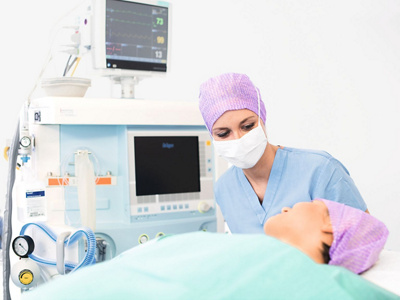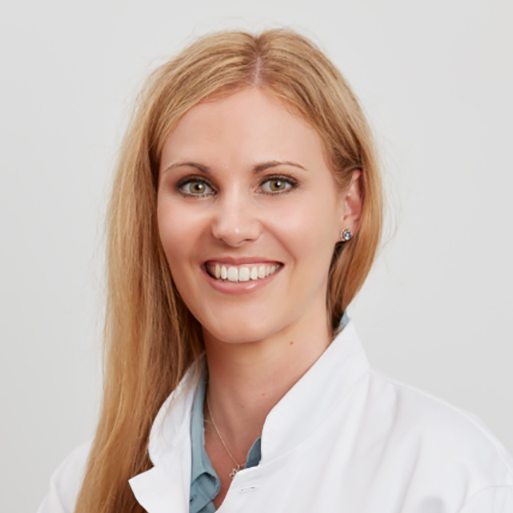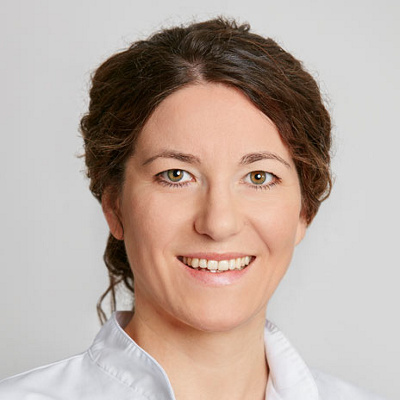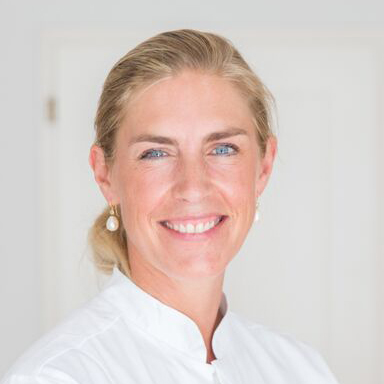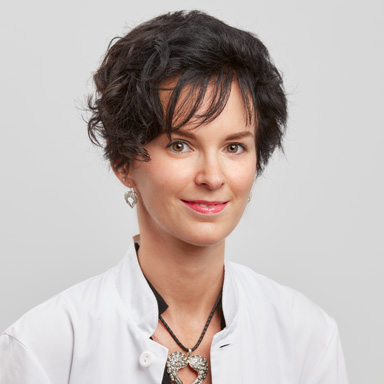We offer you a broad range of modern surgery and medicine. This includes the treatment of various diseases and conditions requiring surgery in the abdomen (visceral surgery, proctology and surgery on the female reproductive organs), surgery on the heart and thoracic aorta as well as plastic/reconstructive surgery of all kinds.
Please see below for more information on our disciplines and specialisations, as well as the various conditions that we treat.
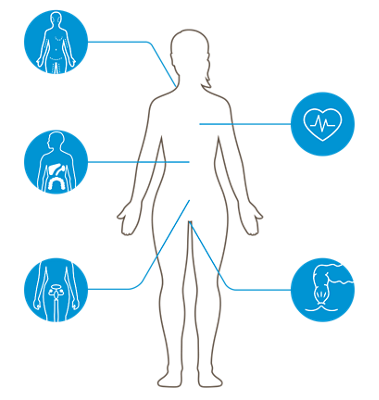
Surgery on the abdominal organs
Abdominal surgery, also called visceral surgery, includes operations on the entire digestive tract, the abdominal wall and the hormone-producing organs (thyroid glands, parathyroid glands, adrenal glands).
Peritoneum
The peritoneum is the membrane that lines the inside of the abdominal cavity. The peritoneum has a large surface area. It surrounds many organs in the abdominal cavity, but also lines the abdominal wall. The peritoneum also produces a lubricating fluid that reduces friction on its surface, making it easier for the organs to move against each other (e.g. as the intestine fills and contracts). One of the conditions that the Klinik Hirslanden treats is tumour of the peritoneum: peritoneal cancer. Find out more (in German)
Pancreas
The pancreas is an organ that is important for digestion and for regulating blood sugar. It is situated in the upper abdomen behind the stomach, and produces up to 1.5 litres of digestive juices every day. It also regulates blood sugar levels by releasing insulin and glucagon from clusters of cells called the islets of Langerhans. At Klinik Hirslanden, we treat conditions such as inflammation of the pancreas (both acute and chronic pancreatitis), as well as benign and malignant pancreatic tumours (mucinous cystadenoma, intraductal papillary mucinous neoplasms (IPMN), neuroendocrine tumours, gastrointestinal stromal tumours (GIST), and pancreatic carcinoma). Find out more

Abdominal wall
Hernias are defects of the structures surrounding the abdominal cavity, and can be either innate or acquired. The structures most commonly affected are the abdominal wall, the umbilical region (umbilical hernia), the groin (inguinal hernia), or, more rarely, the diaphragm (diaphragmatic or hiatus hernia). The cause is usually a certain weakness in the supporting tissue, which gradually gives way. This allows structures in the abdominal cavity to move outwards, giving rise to bulges in the abdomen, which are generally painful. Hernias are rarely dangerous. However, they do often increase in size. In rare cases they can lead to constrictions that can result in blockage of the intestine, or in peritonitis. Other conditions that we treat at Klinik Hirslanden are internal hernias, fractured thighs (femoral hernias) and incisional hernias (hernias caused by the scar tissue giving way following an operation). Find out more

Colon
The colon is generally 100-130 cm long. It draws the water out of digested food to return it to the body. Inflammation often arises due to the large number of different microorganisms within the colon, particularly if the patient has diverticula. These are harmless pouches that can form in the wall of the colon – a condition called diverticulosis or diverticular disease. If the diverticula become inflamed, usually because of the immune system overreacting to components of the stool, this condition can sometimes become chronic. Examples include Crohn’s disease and ulcerative colitis. Bowel cancer (colorectal cancer) is unfortunately on the rise in Western industrialised countries. However, the number of colonoscopy screenings are also increasing, which makes early diagnosis possible. Find out more

Small bowel
The small bowel is between three and five metres long, and is the organ where most ‘resorption’ (absorption of nutrients from food) takes place. Recent research shows that it is of vital importance to our immune system, because this is where the body comes into direct contact with its environment. Among the conditions treated at Klinik Hirslanden are intestinal obstruction due to constriction (adhesions), small bowel infarction (embolism or thrombosis), Crohn’s disease (chronic bowel inflammation), diverticulum (Meckel’s diverticulum) and malignant tumours of the small bowel (GIST, small bowel cancer, neuroendocrine tumours and lymphomas). Find out more

Gallbladder
The gallbladder sits next to the liver. Its job is to store bile, produced by the liver, and to release large amounts of it into the duodenum (the first section of the small bowel) when needed. Bile is important for the digestion of fats and for the absorption of certain vitamins. Among the conditions treated at Klinik Hirslanden are gallstones, inflammation of the gallbladder, gallbladder polyps and gallbladder cancer. Find out more

Liver
The liver is the largest organ in the human body and the only one that can regenerate itself. This attribute, which was even known to the Ancient Greeks (as in the saga of Prometheus), means that we can operate on the liver more than once if necessary. Among the conditions treated by Klinik Hirslanden are benign tumours of the liver (haemangioma, liver cysts, focal nodular hyperplasia (FNH), adenoma), parasitic diseases (alveolar hydatid disease, cystic echinococcosis), liver cancer (hepatocellular carcinoma, bile duct cancer), as well as secondary (metastatic) tumours that appear in the liver. Find out more

Stomach
The complex surgery involved in stomach cancer, as well as any surgery on the esophagus (food pipe) close to the cardia (where the esophagus meets the stomach) is highly specialised medicine. This is because the mortality rate from surgical interventions, as well as the long-term prognosis, depends on the level of experience of both surgeon and institution. In clinics that are highly experienced in operating on the esophagus and cardia region, the mortality rate is 5% or less. Therefore, in many countries, including Switzerland, only selected institutions are permitted to carry out these operations. Among the conditions treated at Klinik Hirslanden are gastroesophageal reflux disease, weight loss surgery/bariatric surgery (stomach bypass, sleeve gastrectomy), stomach cancer and gastrointestinal stroma tumours (GIST). Find out more

Rectum
Like the colon, the rectum removes water from the contents of the bowel in order to produce properly formed stools. It also has an important function in continence, acting as a holding station for the stool being pushed out of the higher sections of the bowel. Unfortunately, the rectum is also a particularly common site for malignant tumours (rectal cancer), which require special surgical techniques to avoid causing incontinence and to maintain sexual and bladder function. In addition, prolapse of the rectum can cause chronic constipation (outlet obstruction) and disorders of defecation. Find out more

Spleen
The spleen is located in the upper left-hand side of the abdomen, under the diaphragm. It plays an important part in the body’s immune system. It also helps with the disposal of old or defective red blood cells (erythrocytes) and platelets (thrombocytes). Among the conditions treated at Klinik Hirslanden are traumatic rupture of the spleen and splenomegaly (enlargement of the spleen). Find out more

Adrenal glands
The adrenal glands sit just above both kidneys. They produce a large number of hormones that are important for bodily functions (e.g. adrenaline, mineralocorticoids, cortisone and sex hormones). Surgery on these organs may become necessary if these hormones are being produced in excessive quantities, usually due to tumours (either hormonally active or hormonally inactive adrenal tumours), or if metastatic or other malignant tumours have spread there. Find out more

Parathyroid glands
The parathyroid glands (there are usually four of them) are situated to the right and left of the thyroid gland. They maintain balanced calcium levels in the blood by producing parathyroid hormone. If these glands are overactive (primary or secondary hyperparathyroidism), they become enlarged. Calcium is then released from the bones, and eventually the bones are weakened, leading to pain and frequent fractures. Malignant tumours can also form in the parathyroid glands. Find out more

Thyroid gland
Various disorders of the thyroid gland can make surgical intervention necessary. These include swelling of the thyroid gland with mechanical irritation (difficulty swallowing or breathing), suspicious or malignant nodules on the thyroid (struma nodosa/multinodosa), disorders of thyroid function (hyperthyroidism/hypothyroidism), or an overactive thyroid that cannot be controlled by medication. Find out more

Esophagus
Surgery on the esophagus, as well as stomach cancer surgery close to the cardia (where the esophagus meets the stomach), is complex and is a highly specialised field of medicine. This is because the mortality rate from surgical interventions, as well as the long-term prognosis, depend on the level of experience of both surgeon and institution. In clinics that are highly experienced in operating on the esophagus and cardia region, the mortality rate is 5% or less. Therefore, in many countries, including Switzerland, only selected institutions are permitted to carry out these operations. The conditions treated at Klinik Hirslanden include esophageal cancer, tumours at the point where the esophagus meets the stomach (Barrett’s carcinoma), gastroesophageal reflux disease with or without diaphragmatic hernia, esophageal motility disorder and diverticulum of the esophagus (e.g. Zenker’s diverticulum). Find out more

Diaphragm
The diaphragm is the layer of tissue that divides the chest cavity from the abdominal cavity. It is a muscle that helps the lungs inhale to their largest possible volume by moving downwards on each inhalation. The diaphragm is the most important respiratory muscle, and a reduction in its function severely limits respiratory capacity. Surgical interventions on the diaphragm are required especially in cases of hiatus hernia, or when a widening of the natural openings in the diaphragm occurs, in particular where the esophagus passes through it. These widenings can lead, for example, to gastroesophageal reflux, where the stomach contents repeatedly back up into the esophagus. Very marked changes in the diaphragm can even lead to the whole stomach riding up into the chest cavity. Find out more

Surgery on the rectum/anus
Proctology deals with disorders of the rectum. This branch of medicine specifically comprises the prevention, diagnosis and treatment of disorders of the anus and the anal canal. The range of treatment includes both non-surgical and surgical options.
Anus
The anus is the opening of the rectum to the outside of the body and is where the bowels are emptied. A wide range of disorders can occur around the anus and in the anal canal.
The transitional zone between normal skin and intestinal mucosa, known as the pectinate (or ‘toothed') line, is the origin of several diseases in the anal canal. For instance, anal fistulae, abscesses and anal tumours occur in this area.
Other anal disorders covered by proctology are haemorrhoids, anal and rectal prolapse, skin tags, anal fissures (tears in the mucosa), coccygeal fistula (pilonidal sinus), anal incontinence, genital warts (condylomata acuminata) and anal skin problems (anal eczema). Find out more
Surgery on the female reproductive organs
Surgical gynaecology covers interventions on the female breasts, womb, ovaries and vagina. These interventions may be necessary due to benign growths (e.g. fibroids, ovarian cysts, endometriosis and mucosal polyps), prolapse (e.g. uterine or bladder prolapse) and its effects, or due to precancerous or malignant growths. Operations on the lower abdomen are usually carried out via laparoscopy (minimally invasive or keyhole surgery).
Peritoneum: in addition to disorders covered by visceral surgery > Endometriosis
Endometriosis is an extremely complex disease. It can produce powerful symptoms ranging from pain to intestinal and bladder problems to infertility; however, in some cases the patient can be completely asymptomatic. It depends above all on where the endometrial lesions occur. Endometrial lesions are – metaphorically speaking – offshoots of the endometrium. This is the tissue which normally lines the womb, and which bleeds during menstruation. If islands of the same type of cells appear in the ‘wrong’ place, we call it endometriosis. Every month their presence leads to severe irritation of the surrounding tissue, with all of the problems that this entails. Endometriosis can either be treated with medication that suppresses menstruation, or the problematic tissue can be surgically removed. Often a combination of the two options is recommended. As the patient with endometriosis often experiences most of her symptoms at child-bearing age, counselling and surgical technique are extremely important. In most cases, endometriosis can be dealt with using minimally invasive surgery, i.e. laparoscopic methods, via small incisions.
Breasts
Breast cancer is the most common malignant cancer in women. However, in the female breast there may even be benign changes whose removal is either advisable or essential. It is especially in the treatment of mammary gland disorders that the important of good collaboration among a network of outstanding female doctors comes into its own; particularly, in such cases, surgical oncologists and plastic surgeons. The aim is to retain the natural beauty of the breast, even if malignant changes have occurred.
Ovaries
The ovaries sit to the left and right of the womb. They are responsible for hormone and egg production from the start of puberty until the menopause. During the course of a woman’s life they can be the origin of disorders that require surgical intervention.
A relatively common problem is ovarian cysts that are benign, but that still require surgery. Endometriosis is another disorder in which not just the ovary, but sometimes even the whole lower abdomen is affected. In most cases, interventions on the ovaries take place using minimally invasive surgery, i.e. via laparoscopy. Infertility can also sometimes be treated by laparoscopic methods, depending on the underlying cause.
Endometriosis is another example of a condition in which the patient gains huge benefit from interdisciplinary planning, and hence from a properly functioning network of designated specialists, as this disorder often affects several organs.
Malignant disorders of the ovaries are rare.
Womb and cervix
Changes to the womb and cervix are common. Changes in the womb are generally manifested via abnormal bleeding, pain or a sensation of the presence of a foreign body in the lower abdomen. They can also be responsible for problems with passing water or emptying the bowels. It is challenging to advise women on operations on the womb, especially if they may want to have children in the future. Nowadays, for typical changes such as fibroids and polyps, there are gentler surgical methods after which the patient would have no problem in carrying a pregnancy to term. In cases like these it is particularly important to provide the patient with comprehensive advice. Should the patient decide, following in-depth advice, on the removal of the womb, or if it is unavoidable from a medical point of view, then this can also be carried out via the minimally invasive technique of laparoscopy.
Changes in the cervix are looked for and discovered during routine examinations (annual screening). Thanks to these regular checks and the vaccination that is available today, cervical cancer has become rare in Switzerland. Any precancerous changes are discovered during checks, and so can be treated early by removing only part of the cervix. The patient then generally has no problem becoming pregnant.
Vagina / Vulva
Operations on or via the vagina are common in our field. The typical reason for these operations is a prolapse. These means that the womb, bladder or rectum slip out of position, either individually or together. This most often occurs following childbirth, in overweight patients, or in old age. The strengthening of the vaginal walls, and possibly the removal of the womb through the vagina and the return of the perineum to its original height is an operation that involves little pain, but requires extensive counselling. The patient should be instructed to train her pelvic floor, and any changes in bowel or bladder habits must be discussed. The vagina and vulva play a central role in a woman's sexual well-being, and time needs to be allowed for counselling on this topic in a gynaecological practice.
Aesthetic and reconstructive surgery
Plastic, reconstructive and aesthetic surgery comprises both the reconstruction of areas of the body, e.g. after accidents or tumour surgery, and cosmetic surgery.
Breasts
Breast cancer is the most common type of cancer in women, with around 6,000 cases being diagnosed in Switzerland every year. As well as chemotherapy and radiotherapy, surgery is also used in its treatment.
In most cases, breast-conserving surgery can be performed. Since the removal of a breast tumor often reduces the overall breast volume, oncoplastic surgery helps to achieve a good cosmetic result while providing great therapeutic safety.
In case of breast cancer, surgery in the axilla is usually indicated to remove the sentinel lymph node and/or other lymph nodes. In this case, a gentle surgical technique is very important. Find out more
The breast is removed in around a third of cases. The skin covering and/or nipple can often be retained. At centres like ours, every woman in this situation is offered breast reconstruction. Breast reconstruction often contributes to the patient’s quality of life following or while living with breast cancer.
Women with a genetic predisposition to or family history of breast cancer (e.g. the BRCA 1/2 mutation) often decide on mammary gland removal and reconstruction in order to reduce their risk. Find out more (in German)
Breast enlargements, reductions or lifts are very commonly performed. They help many women feel better about their bodies. Find out more (in German)
We would be happy to advise you, even if you have already had surgery on your breasts. Find out more (in German)
Face / Skin
The face is very exposed to external influences such as the sun's rays, and is the area where skin changes or tumours most commonly occur. Treatment of these, and reconstructive/corrective surgery following their removal, is one of our specialities in collaboration with dermatologists. Find out more (in German)
We also offer rejuvenating facial treatments (wrinkle treatment, firming, restoring volume, regenerative treatments). Find out more (in German)
Body
When you lose weight quickly, you are often left with excess skin on your body. After pregnancy many women are bothered by a weak abdominal wall, and sometimes by a persistent gap between their vertical stomach muscles (diastasis recti). Corrective and firming treatments for this are part of our range of treatment. Find out more (in German)
Surgery on the heart and chest cavity
Cardiac and thoracic vascular surgery involves the invasive treatment of acquired diseases, injuries or malformations of the blood vessels in the chest cavity (thorax) and heart. The operations we carry out most frequently include bypass surgery, valve surgery, and replacement of the aorta, which can usually be carried out by minimally invasive methods. Highly specialised interventions such as heart replacements and heart transplants are only carried out at university hospitals. This also goes for the care of congenital heart conditions.
Aortic aneurysm/dissection (aortic arch surgery)
The most common disorder of the aorta is its enlargement (aneurysm), generally caused by chronic high blood pressure that has been left untreated (or, rarely, due to a connective tissue disorder). Whatever the cause, an operation is needed when the diameter of the ascending aorta exceeds 5.5 cm in an adult (or, in cases of Marfan syndrome or other connective tissue disorders, 5 cm).
During the operation, the surgeon only replaces the portion of the aorta that is enlarged.
If the aortic root and the aortic valve are both defective, then the entire aortic root can be replaced in one operation.
If the aortic arch is also enlarged, then this can also be replaced at the same time.
Heart valve disorders (valve replacement/reconstruction)
Disorders of the heart valves most commonly affect the aortic valve, followed by the mitral valve.
Heart valve disorders are usually caused by age-related degeneration or a connective tissue disorder. The resulting changes in the valves can, in severe cases, cause problems that hinder patients in their daily lives and can even lead to heart failure. If this is the case, the valve has to be repaired (mitral valve) or replaced (aortic valve) in order to prevent lasting damage to the heart.
If only one or two valves are affected, these interventions are carried out using minimally invasive methods, through a small incision between the ribs.
Cardiac tumour (myxoma)
A tumour in the heart (myxoma) is a very rare occurrence, and is usually benign. It has to be removed once diagnosis is confirmed, due to the risk of embolism. Removal can be conducted by minimally invasive surgery.
Coronary heart disease (bypass surgery)
Coronary heart disease is one of the most common heart diseases. It is a disease of the blood vessels that supply the heart. Deposits (fat, calcium or blood clots) narrow the blood vessels. As a result the blood supply to the heart is reduced, which comes with the risk of a heart attack or cardiac insufficiency. Chest pain (angina pectoris) is a typical symptom of heart disease.
The therapy strategy for patients with coronary heart disease depends on how they present (number of diseased blood vessels) and the stage of their illness.
If all three coronary vessels are affected, then a bypass operation is usually performed. The severely constricted vessels are bypassed using the patient’s own blood vessels (arteries, veins) in order to restore optimal blood supply to the heart muscle. The operation can be carried out either via keyhole surgery without a heart-lung machine, or even just via a small incision between the ribs.

